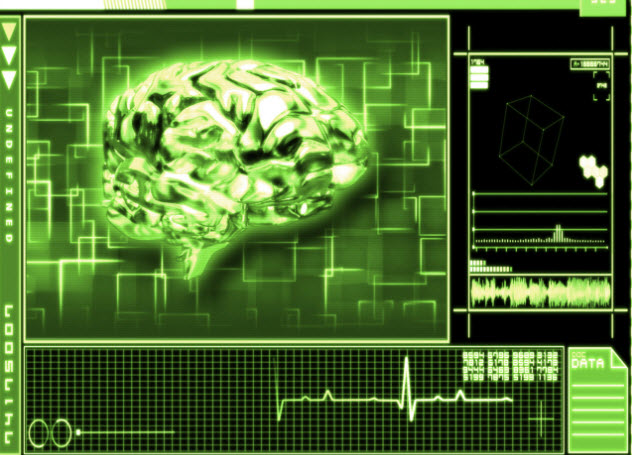 Technology
Technology  Technology
Technology  Humans
Humans 10 Everyday Human Behaviors That Are Actually Survival Instincts
 Animals
Animals 10 Animals That Humiliated and Harmed Historical Leaders
 History
History 10 Most Influential Protests in Modern History
 Creepy
Creepy 10 More Representations of Death from Myth, Legend, and Folktale
 Technology
Technology 10 Scientific Breakthroughs of 2025 That’ll Change Everything
 Our World
Our World 10 Ways Icelandic Culture Makes Other Countries Look Boring
 Misconceptions
Misconceptions 10 Common Misconceptions About the Victorian Era
 Mysteries
Mysteries 10 Strange Unexplained Mysteries of 2025
 Miscellaneous
Miscellaneous 10 of History’s Most Bell-Ringing Finishing Moves
 Technology
Technology Top 10 Everyday Tech Buzzwords That Hide a Darker Past
 Humans
Humans 10 Everyday Human Behaviors That Are Actually Survival Instincts
 Animals
Animals 10 Animals That Humiliated and Harmed Historical Leaders
Who's Behind Listverse?

Jamie Frater
Head Editor
Jamie founded Listverse due to an insatiable desire to share fascinating, obscure, and bizarre facts. He has been a guest speaker on numerous national radio and television stations and is a five time published author.
More About Us History
History 10 Most Influential Protests in Modern History
 Creepy
Creepy 10 More Representations of Death from Myth, Legend, and Folktale
 Technology
Technology 10 Scientific Breakthroughs of 2025 That’ll Change Everything
 Our World
Our World 10 Ways Icelandic Culture Makes Other Countries Look Boring
 Misconceptions
Misconceptions 10 Common Misconceptions About the Victorian Era
 Mysteries
Mysteries 10 Strange Unexplained Mysteries of 2025
 Miscellaneous
Miscellaneous 10 of History’s Most Bell-Ringing Finishing Moves
10 Weird Things We’ve Learned About The Mind And Consciousness
The human brain is weird. So weird that if it were a movie, it’d be directed by David Lynch after he dropped 12 tabs of hard-core acid. Although we might think we know our minds, science has proven time and again that the greatest unexplored region of the universe is inside our own heads.
10Our Brains Can Experience Bullet Time
Before The Matrix became known chiefly for its lousy sequels, the most famous scene in the movie was when Neo experienced bullet time (as shown above). In case you’ve never seen it or the trillion spoofs that followed, bullet time involves the world slowing to such a degree that you can literally see bullets moving through the air. Rather than being fantasy, this is something you might actually experience.
One day a couple of years back, Simon Baker stepped into the shower with a blinding headache. As he stood under the curtain of water, his pain suddenly came to a crescendo. Immediately, the water droplets before him seemed to freeze. According to Baker, it was like they hung suspended in midair. He could even clearly see how the rushing air distorted their shapes as they fell with infinite slowness toward the ground. From Baker’s perspective, time was literally standing still.
It turned out that Baker had suffered an aneurysm. For reasons we still don’t fully understand, this caused him to lose all perception of passing time. Although this was a one-off incident, there had been similar stories reported earlier by other people. Epilepsy sufferers and stroke victims have spoken of time distorting wildly. One Japanese man saw time continue as normal visually but experienced a slowing of sound. When people talked to him, it was like he was watching a badly dubbed movie.
No one is completely sure what causes these experiences, although many theories have been proposed. All we know is that one day you might suddenly discover you have the power to see flying bullets.
9Electrifying Your Brain Could Make You Smarter And Happier
Do you have problems concentrating? Are you depressed, anxious, or simply fatigued all the time? If so, science may have hit on an odd solution. According to a small group of vocal neuroscientists, the quickest way to improve your life might be to electrify your brain.
The idea of putting electrodes anywhere near our skulls probably makes most people think of that scene in One Flew Over the Cuckoo’s Nest (shown above). But transcranial direct current stimulation (tDCS) is very different from electroshock therapy. For one thing, it uses a much lower current: around 2 milliamps for tDCS compared to 800 milliamps for electroshock therapy. For another thing, you can do it in your own home.
Across the world, medical companies are starting to sell home kits for shocking your brain in the comfort of your living room. If that sounds distinctly dangerous, wait until you hear about the guys who are making their own machines. Thanks to helpful threads on reddit, it’s now spectacularly easy to build a horribly unsafe contraption at home with which to blast your mind.
No one would seriously suggest doing that. Really, don’t do it. Don’t use commercially sold home kits, either. This is not something that anyone should try outside of a lab setting right now, even though many are now becoming convinced of the possible uses of tDCS.
In the UK, there have been two large trials to see if tDCS can treat depression, and the US military has conducted a trial to see if it can help with concentration in battle. It may be that we’re not long away from being able to zap our misery away in our own homes.
8Movies Can Influence How We Experience Amnesia

Imagine being in a car crash so horrific that it gave you amnesia. Whenever you’d go to bed, you’d forget everything that happened to you that day and wake up each morning with a clean slate. If that sounds like the plot of a lousy movie, it’s because that’s exactly what happened to Drew Barrymore in the awful 2004 rom-com 50 First Dates. In 2005, it also happened to a woman in real life.
There’s no physiological reason why a car accident should make amnesia play out like that. It’s just a dumb Hollywood gimmick with no grounding in science. Yet this woman suffered the same symptoms. Rather than dismiss her as a fantasist because she was an admitted fan of the movie, researchers reached a bizarre conclusion. The movie’s fake depiction of amnesia influenced how she experienced the real thing.
Her particular type of amnesia is called “dissociative amnesia,” a highly controversial diagnosis because some scholars don’t believe it’s real. With dissociative amnesia, our reaction to trauma manifests in the psychological way that we believe we should react. For example, a Memento fan might exhibit Memento-style symptoms. This woman’s cultural touchstone was 50 First Dates, so that movie dictated how she experienced the real thing.
Incidentally, this isn’t the only weird thing that can influence how we have amnesia. In 2011, a 54-year-old woman experienced such an intense orgasm that she immediately lost the last 24 hours of her memory.
7Even Our Brains Can’t Understand Our Dreams

Picture the scene. You’re just chilling out, reading another brilliant article on your favorite list-based website, when suddenly the screen turns into butterflies, each of which has the screaming head of your mother. In most cases, this would send you sprinting out the door. But not in dreams. In a dream, you’d just roll with it. According to recent research, that might happen because even our brains give up trying to understand our dreams.
A team at the University of Milan recently demonstrated this by getting people to record their dreams along with their waking fantasies. The researchers noticed that dreams were infinitely less logical than waking fantasies.
A month later, they placed the subjects in an fMRI scanner and read their dreams and fantasies back to them. Both dreams and fantasies seemed to trigger a part of the brain associated with complex language learning. But the moment a dream narrative became truly weird, activity in this part of the brain seemed to die down.
The research team concluded that even our brains stop trying to make sense of our illogical dreams at some point, even though our gray matter created the nonsense in the first place.
6AI Dreams Are Even Stranger Than Human Ones

You may not know it, but Google can dream. Sort of. The software uses layers of artificial neural networks (ANNs) stacked on top of one another to process images. Google engineers teach these ANNs what a cat is by showing it a zillion pictures of cats until it can remember for itself.
The technology isn’t perfect, so Google sometimes gets it hilariously wrong. When engineers asked the software to create an image of a dumbbell using only its “memories,” the software created an image of a dumbbell with human arms. Apparently, so many dumbbell pictures include someone holding them that the software thought dumbbells come with arms.
The engineers tried feeding in other images and asking Google to generate its own patterns from them. The results were kind of trippy. Mountains became houses, and flowers became birds. But the breakthrough came when someone decided to feed in white noise. With no patterns to use, the software started producing its own images—what Google staff called its “dreams.” The results were insane.
Google’s “dreams” are like watching an acid nightmare. Patterns replicated in bizarre colors, mountains rose out of impossible landscapes, and pagodas multiplied across all of time and space. The overall effect was like feeding a hyperactive child magic mushrooms and then settling down to a hard-core Minecraft session that breaks the rules of physics. If this is the future of AI, then the coming decades are going to be far more psychedelic than we expected.
5A Condition Can Stop You From Making Mental Pictures

We all know the expression “to picture something in your mind’s eye.” Most of us do it every time we read a book, think about the past, or listen to a friend tell a story. Most likely, we take it for granted. But recent research suggests that not everyone is gifted with this power of internal sight. As many as 1 in 50 of us find it impossible to visualize any images at all.
In a 2015 study published in the journal Cortex, Professor Adam Zeman of the University of Exeter identified this condition and named it “aphantasia.” For sufferers, it can be an isolating experience. One person in the study was unable to remember his mother’s face after she died, which left this person distraught. When another sufferer discovered that other people had a richer visual internal life, he felt isolated.
However, those with aphantasia can otherwise see and recall things perfectly. For example, they’ll know what their girlfriend was wearing this morning, but they’ll recall it without any accompanying image. If you think you might fall into this category, click on this link and scroll down to take a test. It could be that you’ve been suffering from aphantasia all this time without knowing it.
4Synesthesia May Be Learned

The jackpot of medical conditions, synesthesia causes you to do things like see music and taste colors. It may aid creativity and possibly helped physicist Richard Feynman win a Nobel Prize. Although most people believe you have to be born with synesthesia, some people think you can teach it.
In 2013, researchers studied 11 people with a form of synesthesia that caused them to perceive different letters as certain colors. Interestingly, all 11 of them saw these letters with the same colors—“A” was red and so on, all the way to “Z.” If synesthesia is unique for each individual, this shouldn’t be possible.
But another factor was at work. For these participants, the colors of the letters matched the colors used in a popular Fisher-Price fridge magnet set sold in the US between 1972 and 1989.
The researchers concluded that synesthesia likely has a learning aspect to it. While it probably isn’t possible to train yourself to become a full-blown synesthete, some researchers are starting to believe that you can learn some elements of the condition on a temporary basis. Impressively, acquiring these skills may even help your memory and boost your IQ.
3Our Brainprints May Be Unique

There are a couple of almost foolproof ways—such as fingerprints and DNA—to pick out an individual from a sea of faces. Now scientists may have a new method that uses brain patterns.
Each human brain forges connections in a unique way. Researchers recently demonstrated this at Yale University by mapping similar activity in different parts of the brain using a type of fMRI called “functional connectivity MRI” (fcMRI). With the help of their fcMRI, the researchers were able to use brainprints to identify an individual out of a group of 126 healthy adults with 99 percent accuracy.
That’s an astonishing hit rate, and it shows that our brains all work in radically different ways. As reported by Scientific American, one of the lead researchers said: “What we’ve shown is that the same brain doing two different things looks more similar than two different brains doing the same thing.”
While using this method to identify people seems pointless when we already have fingerprinting and DNA, it does show just how unique our brains really are.
2Different Workouts Affect Our Brains In Different Ways

For a few years now, “brain training” games have been all the rage. You’ve probably seen someone post their high scores on Facebook. Despite being repeatedly dismissed by scientists as utter bunkum, these games remain a growth industry.
However, it is possible to give your mind a bit of fine-tuning now and then. Only you don’t need to download a fancy app or anything. You just need a bit of good old-fashioned exercise.
We’ve known for years that exercise can be good for our minds. New Scientist even described an aerobic workout as “medicine for the mind.” But recent research goes beyond simply advising us to do a bit of jogging to ward off dementia. It’s now possible to recommend different types of exercise to improve different areas of your mind.
Just as your physical fitness goals determine what type of exercise you do, your mental fitness goals can also guide your choices. According to a recent report, different exercises can focus your mind for exams, help eliminate cravings, or even allow you to tap your inner creativity. It sounds nuts, but it’s been reported in some serious publications. So forget sudoku. Exercise may be where your brain really gets its nourishment.
1No One Will Notice If Aliens Take Over Your Brain
The 1956 movie Invasion of the Body Snatchers may be one of the creepiest B movies ever put on celluloid. It features alien “pod people” who replace the citizens of a sleepy town with replicas while one man tries to uncover their conspiracy and stop them. Although the movie ends on a famously downbeat note, it would have been even grimmer in real life. Nobody would have noticed the pod people at all.
Recent experiments have shown that we’re terrifyingly bad at knowing when we’re speaking to people who are being controlled by outside forces. To prove this, Dr. Alex Gillespie at the London School of Economics has spent the past few years communicating to unwitting subjects via other people without ever being discovered.
His technique is simple. Gillespie feeds lines remotely to another human, who then parrots them as his own. In one case, Gillespie fed lines to an 11-year-old boy who was being interviewed by a panel of adults. After the boy dazzled them with knowledge of science and economics, Gillespie was amazed to discover that the panel thought the boy had a mental age of 15. Apparently, we’re so conditioned to make judgments based on appearances that we still patronize a kid who has just demonstrated an encyclopedic knowledge of economic theory.
Even scarier, Gillespie has wired people to Internet chatbots to see if anyone can tell the difference. Remarkably, they never can. When someone speaks to an “echoborg” (the person repeating the chatbot’s lines), they never guess that the answers aren’t coming from the human sitting in front of them (even though they might assume the human has certain social issues). So pod people could take over every person around you, and you would never know. Try to keep that in mind next time you’re talking to your loved ones.








